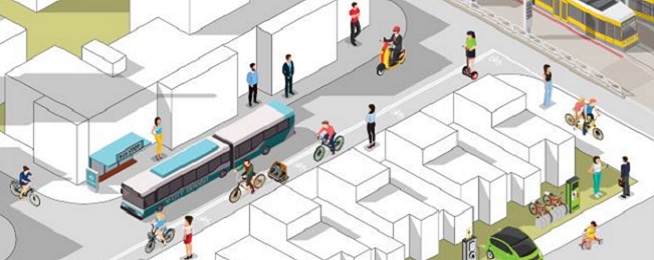The RACT has released five scenarios for Hobart’s transport future and is asking people to comment on each of them.
The survey asks you to rate the scenarios in order of preference and to nominate your top 3 projects.
The scenarios have been released as part of the organisation’s quest for a 30-year vision for transport in Hobart and have been developed by a panel of five transport and planning experts utilising some of the ideas from the public’s 70 submissions.
A forum to launch the scenarios was held at the University of Tasmania, hosted by radio personality Dave Noonan and attended by the Infrastructure Minister, the Hon. Jeremy Rockliff.
The panel of five experts: Jason Byrne, Steven Burgess, Rocco Zito, Anna Lyth, Adrian Bitzios – each spoke to a scenario at the forum.
The scenarios range from business as usual to a complete re-imagining of our transport routes with the River Derwent at the centre.
Encouragingly, scenarios 3, 4 and 5 all feature separated cycleways. Scenarios 1 and 2 look like they follow the current practice of painted, unseparated bike lanes.
Scenario 1 is a predict and provide model, which follows current transport plans for Hobart and as presenter Steven Burgess pointed out, cars are “the most expensive, most dangerous way to get around”. Going on as we always have doesn’t welcome people to the city who don’t want to drive a car, or can’t afford to.
Scenario 2 involved building several large infrastructure projects so vehicle traffic can bypass the city. Adrian Bitzios has experience in delivering large road and public transport infrastructure projects and raised the warning that building big infrastructure projects is expensive, will create more traffic demand and assets have to be maintained over the long term.
Scenario 3 is the model that has been talked about for some time, which would involve a “mode shift” to get people out of cars and onto public transport and active transport.
Presenter Anna Blyth pointed out that to achieve real change, active transport routes would have to be greatly improved, such as the establishment of a network of separated cycleways and public transport would have to be more frequent, reliable and convenient.
Scenario 4 is future looking, with more emphasis on “smart city” technology and autonomous vehicles, as well as converting on-street parking to active and public transport routes and creating one entity to manage private and public transport. Presenter Rocco Zito said some of this technology is available now, but autonomous vehicles still in the research phase.
Scenario 5 imagines an extensive ferry service linking in with “last mile” active transport such as separated cycleways and wider footpaths linking to ferry terminals. Presenter Jason Byrne said Hobart’s transport problems had been created by a “failure of imagination” and cited Brisbane as an example of a complete turn around in the use of a river in just 20 years.


